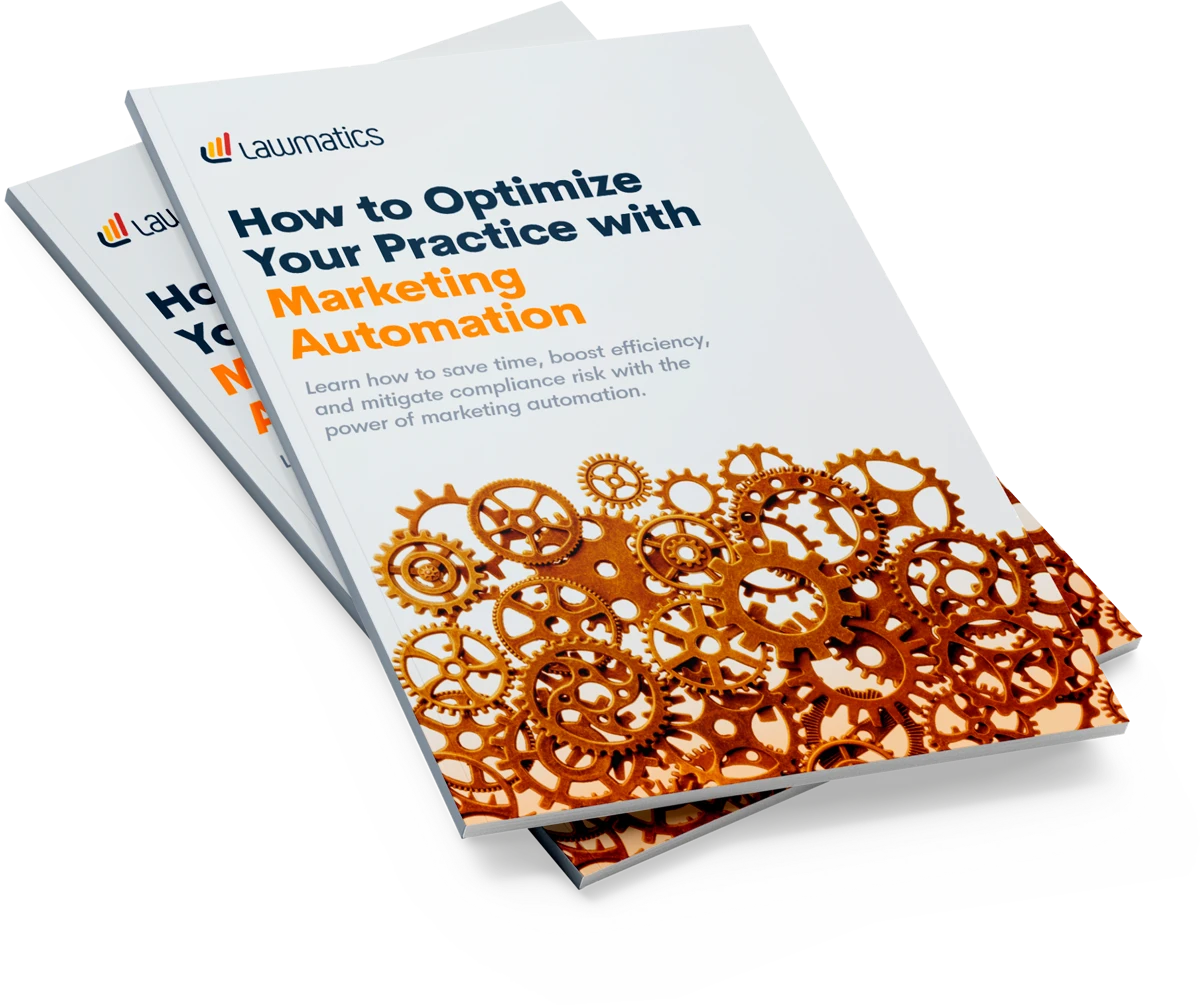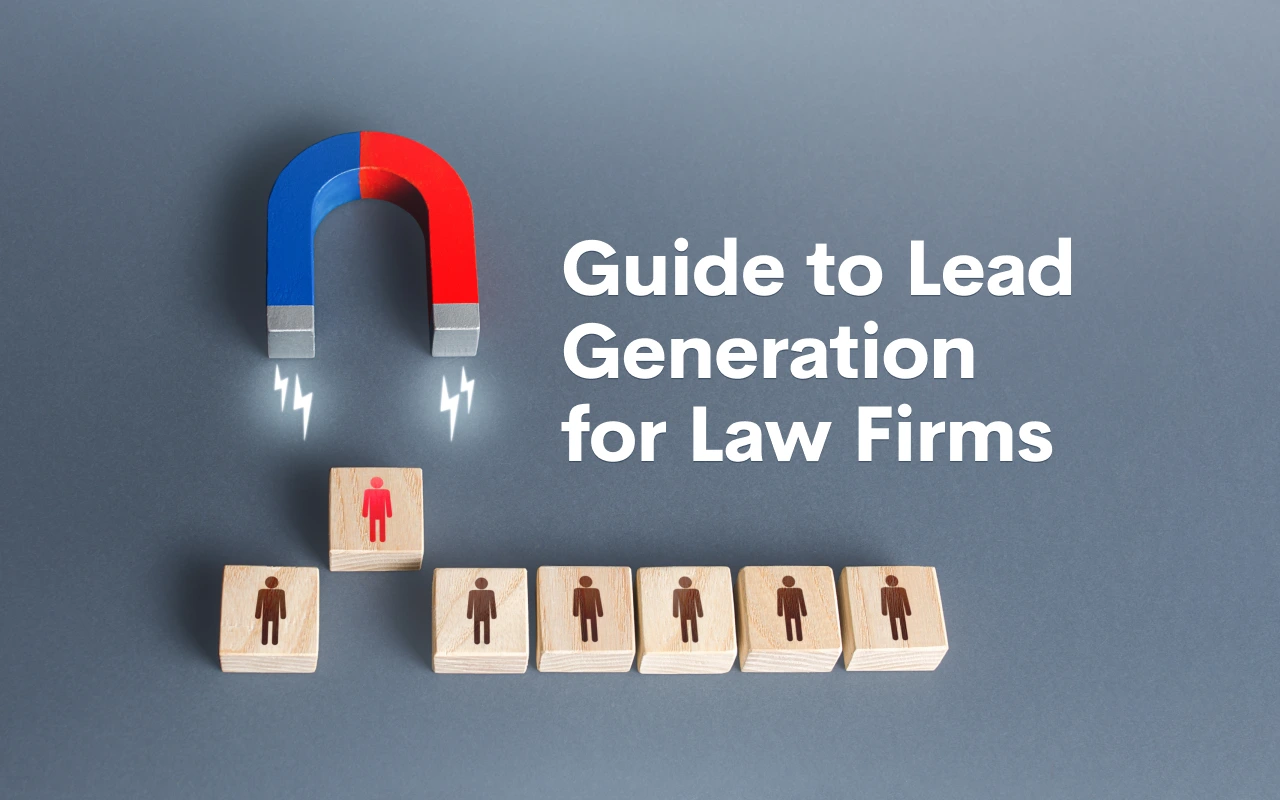Guide to Lead Generation for Law Firms

Clients are the blood that flows through a law firm’s veins — without them, a practice can’t stay alive. To keep the clients flowing, a law firm needs to produce a steady stream of leads. And since law school doesn’t teach you how to run a business, it can be challenging for lawyers to understand all of the complexities involved with attracting and retaining leads. You know — “sales and marketing stuff.”
If you’re a lawyer that feels lost in a fog of foreign business concepts, don’t worry—you’re not alone. After all, you were trained to practice law, not generate leads. However, a successful law firm is one that is run like a business, because that’s exactly what it is. So, law firms looking to stand out to potential legal clients should start thinking like a CEO and make legal lead generation for law firms a part of their business strategy.
What a legal lead is
A lead is a potential client who shows interest in your law firm. Whether they fill out a legal client intake form or call to inquire about whether your law firm is the right fit — a lead is someone who has indicated that they’re interested in paying for your legal services.
Leads are a piece of a broader equation known as a client journey. A client journey can be broken up into three phases:
Intake
The first phase of the client journey begins the minute that a lead first contacts a firm. In order to ensure that an opportunity is never missed, a law firm needs to have an efficient client intake process in place. By using law firm client intake software, law firms can capture a lead’s contact information, input it directly into their database, and track a lead from day one. Software like Lawmatics shows a birds-eye view of where each lead stands, and which ones need to be followed up with.
Without a clear understanding of what actions need to be taken next for each lead, it’s easy to lose track of opportunities. With so many inquiries coming in, many law firms struggle to stay on top of whether a lead has been called or emailed back, potentially letting an opportunity slip through the cracks.
Statistics show that nearly 60% of law firms don't respond to their emails, and almost 35% don't even answer the phone. Unfortunately, slower response times are one of your biggest enemies when it comes to converting a legal lead into a paying client.
Not only does technology ensure that you know exactly what actions need to be taken next to convert a lead into a client, but client intake software will even follow up for you. Email workflows for law firms allow lawyers to focus on their current clients while automation handles incoming leads.
Active matter
Once a lead has been converted into a client, phase two of the client journey begins which is an active matter. A client has officially hired you to represent them in court, and they have signed a fee agreement.
Former client
Once a matter has drawn to a close, a previous client is now known as a former one. However, smart firms know that former clients can be reborn into leads again, so you shouldn’t stop marketing to them. Staying in touch keeps your firm top of mind and encourages repeat business. Former clients are also great sources for referrals!
What lead generation is
Lead generation refers to the process of attracting potential legal clients to your law firm through the act of engaging and nurturing with the hopes of eventually converting them into paying clients. The lead generation process involves incorporating a sales funnel, which is a series of steps intended to eventually convert legal leads into paying legal clients. Your sales funnel eventually gets narrower as prospects navigate through it, just like an actual (you guessed it!) funnel. A sales funnel has four stages.
Awareness
The first stage of a sales funnel is making prospects aware of your law firm. This can be done through many different avenues, whether through paid advertisements, or a Google search, the idea is to make your law firm as visible as possible to get leads to this first stage of the sales funnel and one step closer to being converted to a client. During this stage of the sales funnel, legal prospects are introduced to your law firm for the very first time. Regardless of whether you're a solo practitioner or a larger firm, first impressions count.
Interest
Once a prospect transitions from curious to interested, the second stage of the sales funnel begins. When you've got a prospect’s attention it's time to try to reel in your catch. At this point it’s more important than ever to play your cards right, otherwise, you risk coming off as overly aggressive. Law firms hoping to sway a lead into converting into a client may try methods like establishing their legal expertise or offering a free consultation. The idea is to push your product through a call to action that pushes them to take the next step.
Decision
It's natural for an interested legal prospect to arrive at the point where they decide whether they want to hire you or choose another law firm. With so many competing law firms, it can be a challenge to convince legal leads why they should go with you over the competition.
This is where an effective client intake process is essential. By nurturing and engaging leads, you can say top of mind and increase your chances of them deciding to work with you. Tools like drip email marketing and audience segmentation software deliver a personalized marketing experience that captures their interest more than a one size fits all marketing approach. With workflow automation for law firms, leads feel like you’re giving them special attention, tailored for their unique needs. Send content around their specific pain points and don’t be afraid to ask former clients for a referral.
Showing how you were able to win a case similar to theirs in the past is a strong motivation to choose you as their lawyer!
Action
Finally, at the bottom of the sales funnel sits the action stage. This is when a lead accepts your call to action. In a law firm’s case, usually, this means signing up for a free consultation. The idea is to sell them on why you can solve their case, and how you are the best person for the job.
Understanding the sales funnel is critical for moving your leads through the lead generation process and is the first step towards starting to run your law firm like a business.
How to generate leads for law firms
Now that you’ve got a clearer idea of what lead generation is, let’s examine some of the most popular methods for generating leads.
Optimize your law firm’s website
More online visibility = more leads. One of the best ways to get your law firm’s website at the top of Google search results is by optimizing your law firm website for SEO. Pepper your website’s content regularly with plenty of relevant legal keywords with plenty of reliable backlinks.
Adding a blog to your legal website is another extremely effective method for driving web traffic to your website and generating leads. Double down on your specialized legal niche and establish yourself as an authority on the subject. Don’t be afraid to have a voice and an opinion, and say it loud! In today’s consumer-driven market, people want meaningful content in a legal blog that takes a stance.
Above all, make it visually appealing. Statistics show that blogs lacking visual content perform significantly worse than those that are visually rich. Make it pretty!
Paid ads
Targeted advertisements are a worthwhile tactic for generating leads. Pay-per-click advertising (PPC) makes it possible to pinpoint your ideal demographic, and capture their attention with tailored ads. As the name suggests, you quite literally pay each time a visitor visits your website. You can adjust your budget according to how much you want to spend.
If you decide to invest in a pay-per-click advertising campaign, it’s critical to measure your results. Measuring your ROI requires tracking your website conversions and optimizing your campaigns as needed to generate a nice pipeline of quality leads. Law firm reporting software makes it easy to see how many of your clients are coming from your campaigns and whether it’s worth continuing to invest in or not.
Social media
Ten years ago the idea of promoting a law firm on Instagram or Facebook would have seemed absurd. But, here we are in 2021 and social media is one of the hottest places to market your legal services and generate legal leads. Unlike other marketing techniques, social media offers the unique opportunity to build relationships with leads and clients through a two-way conversation. Traditional marketing doesn’t allow the audience to have a voice and engage in conversation with their favorite brands the same way social media does.
Having a profile alone on social media sites like LinkedIn, Facebook, and Twitter isn’t enough to generate leads. You’ll need to produce engaging and shareable content that drives people to your page and enhances your web traffic. For more tips on how to leverage social media to generate leads, go here.
Create a Google Profile
Did you know that over half of Google users use it to search for businesses? In other words, you need to make yourself visible on Google pronto. Most people don’t have the time to research each law firm individually — they rely on Google to tell them where the best-reviewed place to go is.
In the age of Amazon and Yelp, people are much more likely to become a client of a law firm that comes highly recommended. So, don’t forget the importance of building a strong reputation for your law firm by getting a few great reviews under your belt.
Although there are many different review sites, Google should be your primary focus as a lawyer. Setting up a business profile is free, and can be one of your best lead magnets if you manage to get great reviews.
Don’t be afraid to ask your clients to leave you a review if they had a great experience with your law firm. Usually, happy clients are more than willing to help you out in achieving a five-star reputation by leaving a nice review. Don’t forget the importance of monitoring whatever review sites you’re present on, and always reply to reviews—good and bad!
A common misconception is that you should only reply to negative reviews which couldn’t be further from the truth. Respond appropriately either thanking a client for a positive review or offering a solution or apology to a less than stellar review. If you get a bad review or two, don’t panic. A few negative reviews should fade into the background as long as you continue to acquire positive reviews.
Networking
Don’t let the king-pin reputation of digital marketing convince you that old-school methods don’t still hold value! Making face-to-face connections is still a powerful way to generate leads. Nearly 75% of consumers say that they value word-of-mouth referrals for making a purchasing decision. So, in addition to upping your digital marketing game, don’t forget the value of getting out there and growing your practice the old-fashioned way.
Some ideas for places to network include:
Buy leads
Many law firms rely on the straightforward, effective method of buying leads from law firm lead generation services. Investing in a law firm lead generation company is a simple way to bring in an influx of new business. However, many lawyers will argue that it’s hardly the most cost-effective method since some law firm lead generation companies charge on a pay-per-lead (PPL) system, ranging as high as $700 each.
It’s also important to mention that some lead generation for law firms provide multiple lawyers with the same leads, resulting in an onslaught of calls to overwhelmed prospects, who in turn, are less likely to be receptive to these marketing efforts. So, if you’re going to buy legal leads, make sure that you choose the right company.
If you do go the route of buying leads, it can’t be stressed enough how critical it is to have an extremely responsive intake process in place that tracks each incoming lead through each stage of their client journey.
For this reason, law firms should rely on legal client intake software to ensure they can keep up with the influx of incoming inquiries. To maximize your return on investment (ROI,) your law firm needs an automated system in place. If you buy leads only to manually gather information from each incoming contact, you risk not only losing track of your leads, but you’re losing astronomical amounts of time compared to leveraging automation to do it for you.
Deals and promotions
It’s human nature — people just love a good deal. Offering a promotion or giveaway can be a powerful way to incentivize people to visit your website. Offering a free initial consultation is an extremely effective way to get new leads in the door.
You may even want to consider teaming up with a website like Groupon to offer a coupon for legal services. Just make sure that you are up to date on the latest industry ethics standards to make sure that any deals you offer are structured appropriately.
Marketing automation
Law firm marketing can be downright time-consuming. Luckily there’s a better way — marketing automation for law firms makes it simple to generate leads on auto-pilot so you can focus on what you went to school to do — practice law.
With email automation for law firms, you can streamline your marketing strategy by delivering the right message to the right contact at the right time. Text messaging software for lawyers allows you to communicate with your clients instantly. Tools like audience segmentation software breaks your contacts up into groups based on certain characteristics and sends out tailored marketing that makes it that much more likely that your email breeds a future client.

How to Optimize Your Practice with Marketing Automation
No matter how your leads find you — deliver a powerful legal intake experience powered by Lawmatics
For a lot of lawyers, the idea of generating leads can be downright overwhelming. Law school prepared you for plenty of things, and unfortunately, lead generation wasn’t one of them.
But by developing a strong marketing strategy that delivers a consistent message that’s true to your brand, you’ll manage to bring in a steady stream of promising leads for your law firm, and in turn a healthy future. Yet, generating leads is only half the battle. Once you get a lead in the door, it’s critical to deliver top-notch attention that leaves them wanting to become a client at your firm over the competing law firms in your area.
Lawmatics CRM for lawyers and attorney intake software streamlines the often tedious and time-consuming aspects of running your law firm so you can focus your energy on revenue-generating tasks.
From the initial contact, all the way to signing a retainer — Lawmatics offers an all-in-one solution that takes care of it all for you. Are you ready to see why Lawmatics is recognized as the most intuitive and robust CRM and client intake platform specific to the legal industry? Sign up for a free demo today!


